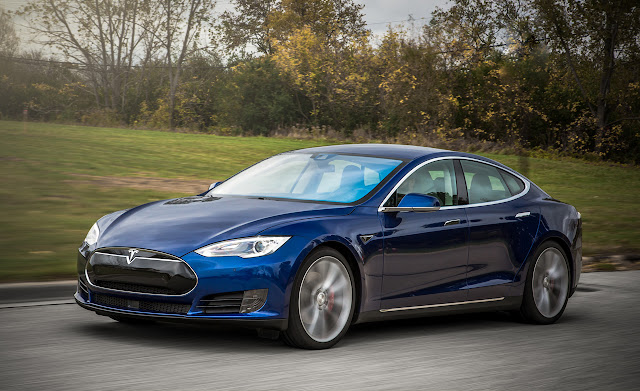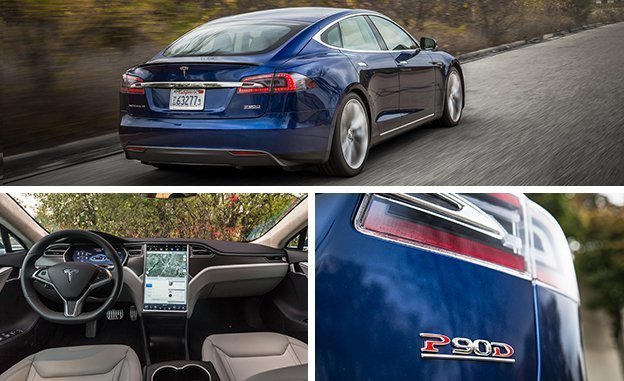Tesla’s product architect, Elon Musk, must have been watching a Mel Brooks marathon on TNT when he picked “Ludicrous Speed,” straight out of Spaceballs, as the tag for the fastest acceleration mode in his Model S P90D. And indeed, one must have balls from outer space to fully exploit this car’s launch performance. To sort heroic acts from hype, we ran this electric missile through our test gantlet with, shall we say, shocking results.
Cutting to the chase, it’s the first production car with four doors to crack the 3.0-second zero-to-60-mph barrier, doing it in 2.8 seconds. In 30-to-50-mph passing acceleration, it trumps the Tesla Roadster Sport’s all-time record run of 1.5 seconds, also by two-tenths of a second. The P90D’s 11.1-second, 121-mph quarter-mile run, achieved with no hint of tire smoke or exhaust ruckus, merits VIP parking at NHRA headquarters. The Model S P85D in Insane mode, formerly the quickest Tesla, was a half-second slower to 60 and 0.7 second and 7 mph pokier in the quarter-mile.
Due care is necessary to achieve these results. Options that add ballast, including the Model S’s huge sunroof, rear-facing seats, and second battery charger, must be avoided. It’s a $38,000 upgrade from a base Model S 70 rear-drive version to obtain the most-potent electric motors, the four-wheel drive, and the long-range 90-kWh battery pack. Then add the $10,000 Ludicrous Speed option to enable the on-demand disappearing services. A full cardiac work-up is recommended for anyone interested in experiencing Tesla’s latest abuse of common sense.
Maximum acceleration is available only when the battery’s state of charge is above 95 percent and “max battery performance mode” is set on the control screen. When we test, we average two acceleration runs in opposite directions to eliminate wind and grade effects. Normally that’s no issue, but because the Model S’s performance deteriorates with heat build-up in the battery pack, controllers, wiring, and electric motors, pausing at least three minutes between acceleration runs is necessary.
This Tesla’s exploitation of Newtonian physics tops anything you’re likely to encounter this side of an amusement park or the Navy’s flight school. Nailing the right pedal vents a massive torque gush, and weird, wonderful, and addictive bursts of dopamine flood your brain’s pleasure center when this tsunami sloshes the juice in your inner ear.
GOLLY G’s
Checking our data bank for outliers, we found this Tesla ranks fourth among five cars capable of averaging more than 1.0 g during the first second of acceleration:
Porsche 911 Turbo S ................................. 1.25
Lamborghini Huracán LP610-4 ................ 1.19
Porsche 918 Spyder .................................. 1.14
Tesla Model S P90D .................................. 1.12
Audi R8 V-10 Plus ...................................... 1.08
Lamborghini Huracán LP610-4 ................ 1.19
Porsche 918 Spyder .................................. 1.14
Tesla Model S P90D .................................. 1.12
Audi R8 V-10 Plus ...................................... 1.08
And we’d add an honorable mention for the Bugatti Veyron 16.4 at 0.95 g.
That’s the beauty of chambering 713 pound-feet of torque into a four-wheel-driver weighing 4842 pounds. Sir Isaac didn’t lie when he told you great things are possible without bending or bruising his second law of motion. You hope the rush lasts to orbital escape velocity but, alas, it soon peters out. Roll alongside a Dodge Charger SRT Hellcat at 40 mph, for example, and the Mopar beats the Tesla to 150 mph by more than six seconds.
An interesting consolation race would be to see whether the Hellcat or the P90D would be the first to deplete its fuel supply. For now, we are satisfied in the knowledge that this is the quickest production four-door ever conceived.










0 commentaires:
Enregistrer un commentaire